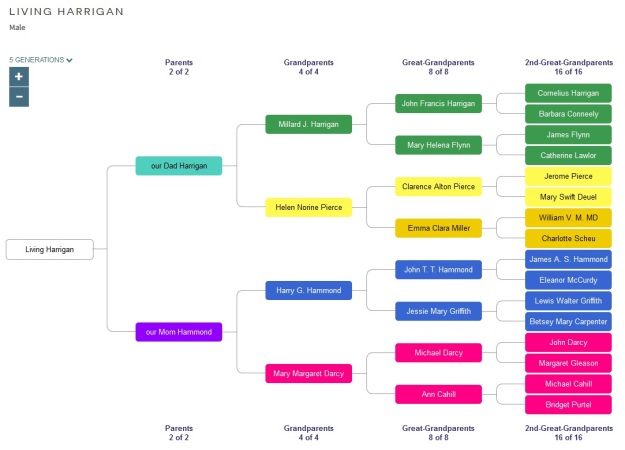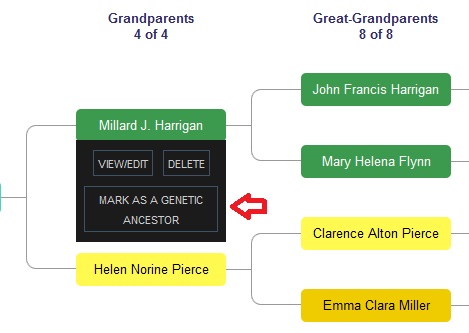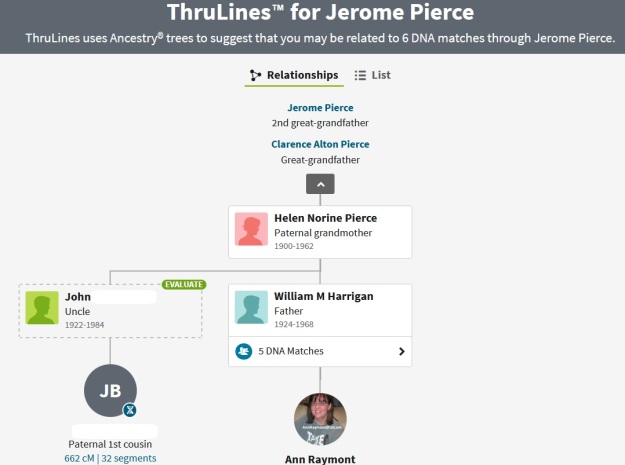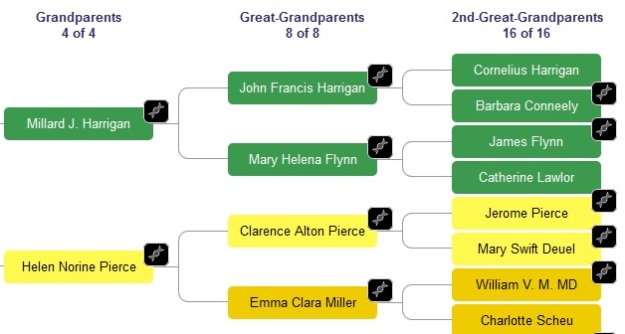My genealogy research has been stalled a bit during this pandemic, with many libraries and archives closed to keep the public safe. So this month, I’ve been indulging in a fun little DNA challenge–have you tried this one?
What’s the challenge?
Look through your family tree and identify each direct ancestor for whom you have evidence that he or she is biologically related to you. Are there any that might be a case of misattributed parentage?
How do you play?
I play that if I have a DNA match descended from a sibling of my direct ancestor, and the amount of DNA my match and I share is consistent with our documented relationship, then that’s evidence that my ancestor is genetically related to me.
For example, how do I know that I am really the biological grandchild of Millard Harrigan? Millard’s sister Mary had a son Delmar: he’s my dad’s first cousin and therefore my first cousin once removed (1c1r). Delmar took a DNA test and he and I match on 440 cM. The Shared cM project indicates that the average amount of shared DNA for 1c1r is 433 cM, with a valid range of 102 to 980. Although matches near the extreme ends of the range would require a little more analysis, that’s not the case here. Delmar, at 440 cM, is a near perfect match for 1c1r. His mom and my Granddad were siblings on paper, and DNA supports that. So this is evidence that I am biologically related to my Granddad. (And by extension, to at least one of his parents, if not both.)
Sidebar: this is nice to confirm! My Granddad was born in 1897, but he doesn’t appear with his family until the 1910 census! I might wonder if he was adopted after 1900, but this DNA match (among others) suggests that it was just an oversight by the 1900 enumerator.
The fun tool
DNApainter.com has many fun tools. Some are open to anyone; others require you to register. For this challenge, I use Ancestral Trees, which require a free DNAPainter account. See image 1 for 5 generations of my tree there.

Image 1.
You can have one tree at no charge; if you want to manage more than one, you need a paid subscription. You can manually input the names from your tree (I did), or import a gedcom.
When you have confirmed you have evidence of a biological relationship with an ancestor, you put your cursor over that person’s name in the tool, and from the choices that appear, select Mark as a Genetic Ancestor. See image 2. (Note: I certainly share DNA with at least one of his parents but I can’t be sure yet if it’s both or not, so I’m only marking Millard for now.)

Image 2.
How far back can you go? Do you have matches descended from a sibling of all 4 grandparents? All 8 great-grandparents? All 16 great-great-grandparents?
If your match is the same generation as you, we are talking about matches like these:
- to confirm you inherited DNA from a grandparent, you match a documented second cousin (2c): avg shared cM 229
- to confirm a great-grandparent, you match a documented 3c: avg shared cM 73
- to confirm a great-great-grandparent, you match a documented 4c: avg shared cM 35
Considerations and caveats
Are you thinking, wait a minute! If I match a first cousin, why doesn’t that prove I’m biologically descended from my grandparents? Why do I have to look for a 2c descended from a grandparent’s sibling? Here’s my thinking. It’s possible that you and your confirmed-on-paper first cousin really only share one grandparent and not both. A full first cousin matches you in a range between 396 and 1397 cM. A one-half first cousin matches you in a range between 102 and 980 cM. So if I match my first cousin Julie with 600 cM, it’s not as convincing that we share both grandparents, Millard and Helen. But if I match someone descended from Millard’s sibling, I know I have DNA from Millard. And if I match someone descended from Helen’s sibling, then I know I have DNA from Helen.
What if a direct ancestor is an only child? My Nana, Helen, was. So I go up a generation, and see if I match a 3c who is descended from a sibling of Nana’s dad Clarence Pierce and a different 3c descended from a sibling of her mom, Emma Miller. If I’m successful, I mark Clarence and Emma as genetic ancestors, and the tool will automatically mark Helen as my genetic ancestor.
What if my only child scenario is farther back? If I’m looking for someone descended from a sibling of my great-great grandparent, that would be a 4c. And I may not share any DNA with a cousin at that distance. But if my siblings or cousin or aunt or uncle match them, in the expected range of shared cM, that’s good enough for me, and I’ll mark the person in question as a genetic ancestor of mine.
Of course, there are limits to how far back it’s practical to draw conclusions about our genetic tree. The farther back we go, the less certain we can be that the shared DNA comes from the common ancestor we know about, and not someone else, on a different line we may not have researched back that far. (After all, a single shared segment of 20 cM could come from a common ancestor 10 generations back.) So for the purpose of this challenge, I might try to go back 5 or 6 generations, while remembering that matches are only indirect evidence supporting a hypothesis of biological kinship–they aren’t proof.
Here’s a quick-n-easy way to find genetic evidence for your ancestors if you’ve tested at AncestryDNA and connected your DNA test to your tree: ThruLines. Just remember that you are looking for ancestors with siblings who produced your DNA matches. For example, Image 3 shows the Thrulines entry for my great-great-grandfather Jerome Pierce. See any siblings? So this is not genetic evidence that I’m descended from Jerome. Or Clarence. Or Helen. I don’t have DNA matches descended from siblings of any of them. This is evidence I’m biologically related to William, because I match a descendant of his sibling, in the expected amount of DNA.

Image 3.
You can identify genetic ancestors without ThruLines too. Whether using ThruLines or not, your conclusion that you have genetic evidence depends on matches having reliable trees (you may want to confirm them yourself) and the size of the match. That means matching DNA segments over 15 or 20 cM, to reduce the risk of false positives, as well as the previously mentioned shared cM total that supports the proposed relationship.
Next step
When you’ve marked as genetic ancestors all those kin for whom you have found DNA evidence, you’ll want to look at your pedigree chart again. Click the [DNA filters] drop-down seen in Image 4 to select Show genetic ancestors. You can also move the slider shown below to display more or fewer generations, and zoom in or out with the +/- buttons.

Image 4.
Selecting Show genetic ancestors prompts DNApainter to redraw the tree with DNA icons for the ancestors we have individually updated.
How’d I do? Great-grands and great-great-grands
I found DNA evidence that I’m genetically related to all 8 of my great-grandparents. But I can only claim the same for 12 of my 16 great-great-grandparents. Who is missing?
Three of those 4 ancestors were Irish immigrants, and I haven’t identified any siblings, aunts, uncles or cousins for them yet. Image 5 depicts my dad’s side, with DNA icons showing who does and doesn’t have genetic evidence so far.

Image 5.
What will I do with this information?
Cornelius Harrigan… I have no clues to his birth family, but we’ve done Y-DNA testing. Our closest match (a genetic distance of 4 at 67 markers) is a Harrigan. And 4 of the top 7 are Harrigan spelling variants (the others random). I’m going to take that as evidence that I am biologically descended from Cornelius Harrigan and I’ll update my genetic tree to reflect that.
Kate Lawlor… I’m just going to monitor and hope someday more matches will help. (Ditto for Michael Cahill, on my mom’s side.)
Charlotte Scheu was born in Buffalo NY in 1852, the mother of my ancestor Emma. I don’t match any descendants of Charlotte’s 8 brothers and sisters. Is it possible her daughter Emma involves a case of Misattributed Parentage, and she didn’t really have Scheu DNA to pass down to me? Here are some steps I considered.
- Maybe I should try to find living descendants of Charlotte’s siblings (they’d be my 4th cousins) and recruit one or more to take a DNA test. It turns out one sister died at the age of 6; the other two never married. And all five of her brothers died in their 20’s. By 1917, there was only one living descendant of Charlotte’s siblings, and I lost track of him after that year. This seems to be a valid reason not to match anyone descended from Charlotte’s siblings.
- Re-examine the genealogy. My new question is, how likely or possible is it that Emma, born in 1882, was not the biological daughter of Charlotte. Am I confident that Charlotte’s 1876 marriage date is reliable? My source was the 1900 census; a more contemporaneous record would be better. Does Emma have older and younger siblings? She’s the third of five children; that does reduce the likelihood of an MPE. That’s especially true when her father is confirmed. I have DNA matches descended from siblings of her father; it’s her mother’s side I lack.
- I could go up a generation and track siblings of Charlotte’s parents…. But her parents were both born in Germany, which so far appears to limit my DNA matches. And those matches would be my fifth cousins, with a much greater risk that we didn’t inherit any matching DNA segments from our common ancestor.
So… I’m not feeling too suspicious about the current lack of Scheu matches. But if you have a great-great-grandparent or closer with no genetic evidence to support the paper trail, you might consider similar analysis.
What of my 32 great-great-great-grands?
For fun, I went one more generation further back. Only 12 of my 32 great-great-great grandparents were born in the U.S. Of those, I have DNA evidence for 10 of them. But I’m aware that marking them as genetic ancestors may be a little overconfident. At that distance, the small match sizes and the increasing odds of incomplete or inaccurate trees means the common ancestor might be someone else. No one will ever see this tree but me (unless I share the link with someone), so I can do whatever feels best to me. I will mark them as a genetic ancestor if I have multiple matches over 20 cM, from several different siblings, if possible.
Still, I want to focus on the two where I have no evidence at all yet supporting my biological descent. These are James Hammond b. 1806 PA and his wife Nancy Agness Ann Jameson b. 1810 KY. (I don’t yet know their parents or any siblings. The Hammond cousin who took a Y-DNA test for me had zero matches!)
Why take the genetic tree challenge?
I have three reasons:
- To challenge my assumption that none of my direct ancestors involved MPE (misattributed parent events). I honor all the families that raised my ancestors, whether they were biological parents or not. But it doesn’t mean I’m not curious….
- To re-prioritize my genealogy projects? Especially when research stalls, it can be helpful and fun to pick up a different branch to explore. Is there some line I want to trace down to living cousins, and reach out to see if they have taken a DNA test or might be interested? Is there some other line where I might want to refocus my documentary research? (I’m looking at you – Hammond/Jameson!)
- Who doesn’t like playing with colorful and easy DNA tools, just for the fun of it?
Have you given it a try?
© July 2020 Ann Raymont, CG®

I can’t wait to try this!
LikeLiked by 1 person
That looks like so much fun.
LikeLike
ok, that was fun. My Genetic Ancestors are 7 of 8 Great-Grandparents and 8 of 16 for 2nd GG. I did make some discoveries and now have a better idea of new places I should focus my research time. It makes a cool colorful chart also. Thanks for suggesting this.
LikeLiked by 1 person